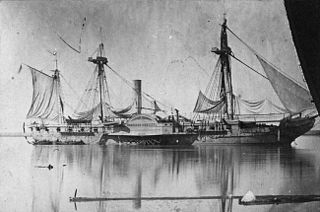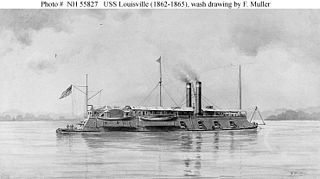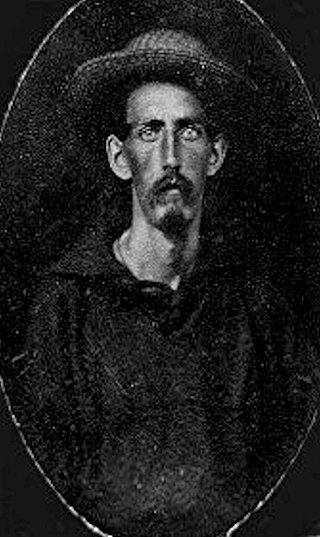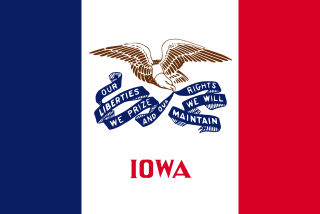
The first USS Rhode Island was a side-wheel steamer in the United States Navy, commissioned in 1861.

USS Mississippi, a paddle frigate, was the first ship of the United States Navy to bear that name. She was named for the Mississippi River. Her sister ship was Missouri. Her keel was laid down by the Philadelphia Navy Yard in 1839; built under the personal supervision of Commodore Matthew Perry. She was commissioned on 22 December 1841, with Captain W. D. Salter in command and launched several weeks later.

USS Louisville was a City-class ironclad gunboat constructed for the U.S. Army by James B. Eads during the American Civil War.

John Gordon Morrison served in the American Civil War, receiving the Medal of Honor in 1862.
Bartlett Laffey was an Irish-born United States Navy sailor and Medal of Honor recipient.

USS Baron DeKalb was a City-class ironclad gunboat constructed for the Union Navy by James B. Eads during the American Civil War.
James Dougherty was a U.S. Marine in the 1871 Korean Campaign. He received the Medal of Honor for actions during the Korean Expedition, while serving as a private aboard USS Benicia. His Medal of Honor was issued on February 8, 1872, under General Order No. 169. Private Dougherty was one of fifteen United States sailors and Marines who received the Medal of Honor for this little known American military action.

The 4th Iowa Cavalry Regiment was a cavalry regiment that served in the Union Army during the American Civil War.
William Moore was a United States Navy Medal of Honor recipient.
Pierre Leon was a Captain of the Forecastle in the Union Navy and a Medal of Honor recipient for his actions in the American Civil War.

Michael A. Huskey was a Union Navy sailor in the American Civil War and a recipient of the United States military's highest decoration, the Medal of Honor.

The Yazoo Pass expedition was a joint operation of Major General Ulysses S. Grant's Army of the Tennessee and Rear Admiral David D. Porter's Mississippi River Squadron in the Vicksburg campaign of the American Civil War. Grant's objective was to get his troops into a flanking position against the Rebel defenders. The expedition was an effort to bypass the Confederate defenses on the bluffs near the city by using the backwaters of the Mississippi Delta as a route from the Mississippi River to the Yazoo River. Once on the Yazoo, the Army would be able to cross the river unopposed and thus achieve their goal. The operation would require a deep penetration into enemy territory that was dominated by water, so cooperation between the two services was necessary. The Army was led by Brigadier General Leonard F. Ross. Naval commander was Lieutenant Commander Watson Smith, whose extremely poor health was an important factor in the ultimate failure of the expedition.
The 58th Ohio Infantry Regiment was an infantry regiment in the Union Army during the American Civil War.
Chicago Mercantile Independent Battery Light Artillery was an artillery battery that served in the Union Army during the American Civil War.

Charles Robinson was a Union Navy sailor in the American Civil War and a recipient of the U.S. military's highest decoration, the Medal of Honor, for his actions during an expedition on the Yazoo River.
William Martin was a Union Navy sailor in the American Civil War and a recipient of the U.S. military's highest decoration, the Medal of Honor, for his actions at the Battle of Forts Jackson and St. Philip.

Boatswain's Mate William S. Bond was an American soldier who fought in the American Civil War. Bond received the country's highest award for bravery during combat, the Medal of Honor, for his action aboard the USS Kearsarge near Cherbourg-Octeville, France on June 19, 1864. He was honored with the award on 31 December 1864.
Robert Williams was an American sailor and recipient of the Medal of Honor during the American Civil War. Little is known about Williams except for information regarding his Medal of Honor action. He served aboard the USS Benton as a signal quartermaster and earned his medal for actions during the Yazoo River (Mississippi) Expedition from December 23–27, 1862, specifically on December 27 at Drumgould's Bluff.
William Martin (1835-1914) was a Union Navy sailor in the American Civil War and a recipient of the U.S. military's highest decoration, the Medal of Honor, for his actions during the attack on Haines Bluff, Yazoo River, 27 December 1862.
USS Romeo was a sternwheel steamer that saw service as a tinclad warship during the American Civil War. Completed in August 1862 for civilian trade on the Wabash River, she was instead purchased by the Union Navy for military service in October. Commissioned in December, she cleared naval mines on the Yazoo River later that month before participating in the operations against Confederate-held Fort Hindman in January 1863. After the fall of Fort Hindman, Romeo was part of an expedition up the White River. In February and March 1863, she was part of the Yazoo Pass Expedition, and she fought with Confederates at river landings later in the year to help isolate Vicksburg, Mississippi, during the Vicksburg campaign.









